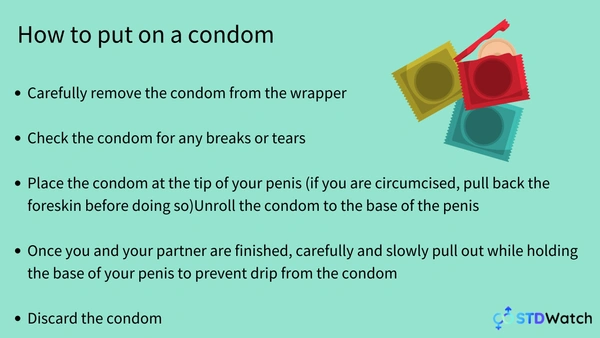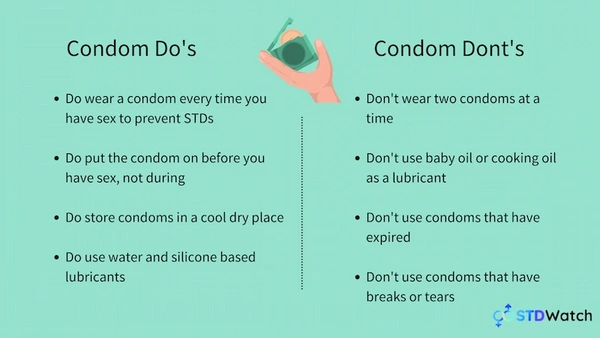- Written by Hannah Kingston - Updated on August 11th, 2021
- Medically reviewed by Dr Andrea Pinto Lopez, M.D.
“How to put on a condom” is one of the most popularly searched sexual health topics that is searched online today. Here is a comprehensive step by step guide on how to put on a condom. We also talk you through some of the most common sex facts and myths today.
It may seem obvious, but first things first, put a condom on before you start having sex! If you start having sex, and only put the condom on when you are close to ejaculating, it lowers the efficiency of the protection you are using.
Simply, the condom must be put on before the sex starts.
How to put on a condom
Here’s a quick step by step guide on how to put on a condom:
- Carefully remove the condom from the wrapper
- Check the condom for any breaks or tears
- Make sure the condom is the right way around. The rim of the condom should be rolling up around the edge of the condom, giving it the appearance of a little hat. If you put on a condom the wrong way around, don’t flip it over to use it. Discard it and grab a new one.
- Place the condom at the tip of your penis (if you are circumcised, pull back the foreskin before doing so)
- Unroll the condom to the base of the penis
- Once you and your partner are finished, carefully and slowly pull out while holding the base of your penis to prevent drip from the condom
- Discard the condom by sliding it off, and wrap it in a tissue or toilet paper before throwing it in the trash.
Take a screenshot of this easy to use guide so you have access to it for whenever you need it!
Condom facts & myths
Here are some common condom facts & myths that you should be aware of:
1. You should wear a condom every time you have sex to prevent STDs.
- FACT. Male and female condoms are the only contraceptive methods that can also protect you against sexually transmitted diseases.
2. You need to put the condom on before having sex.
- FACT. The condom needs to be placed on the penis before penetration to ensure that you are protected by the condom.
3. Condoms should be stored in a cool, dry place.
- FACT. Condoms should be stored in a cool, dry place to ensure that they are in optimal condition. If they are stored in very hot temperatures, it could make it easier for them to tear or break.
4. Water-based or silicone-based lubricants are the most effective for preventing breakage.
- FACT. Water and silicone based lubricants ensure that there is less friction during sex, which helps to keep the condom intact.
5. Wearing two condoms will offer better protection.
- MYTH. Wearing two condoms increases the chances of friction and therefore, condom breakage. One condom is sufficient.
6. Baby oil or cooking oil can be used as lubricants.
- MYTH. You should only use lubricants that have been medically approved and are fit for purpose, otherwise you could cause irritation for either yourself or your partner. Additionally, oil-based lubricants can break down latex condoms, causing them to break.
7. Reusing a condom is fine as long as it isn’t broken.
- MYTH. Condoms should never be reused. A used condom has a higher chance of breaking and it is unhygienic to do so.
8. It’s okay to put on a condom just before I ejaculate.
- MYTH. Remember. Always put the condom on before you start to have sex.
9. The pull-out method is equally as effective as condoms.
- MYTH. The pull-out or withdrawal method is risky. Pre-cum or failure to withdraw in time could result in pregnancy, and you won’t be protected against STIs.
10. Condoms don’t have an expiration date.
- MYTH. All condoms have an expiry date, make sure to check the packaging.
11. If the condom has a small break or tear, it’s okay.
- MYTH. A small break or tear could be enough to result in pregnancy. Always have more than one condom in your room and you will be good to go!
While the ins and outs and ups and downs of condom use can feel intimidating at the start, it is always worth the peace of mind to know that you are as best protected as you can be before having sex.
Nothing is as sexy as peace of mind!
Do “ultra thin” condoms break more easily?
“Ultra thin” condoms do not break more easily than regular or “ultra safe” condoms. All condoms that are currently on the market have undergone rigorous testing.
Though there are different types of condom materials and styles, there is no “break-proof” condom on the market. Putting on a condom correctly gives you the best chance of protection.
When it comes to STD protection, Planned Parenthood recommends that condoms made of latex, polyurethane, and polyisoprene offer the best protection against STDs, while natural condoms made of lambskin offer the least. For this reason, lambskin condoms are recommended for monogamous couples who are only trying to prevent pregnancy, rather than for STD prevention.
Is it possible to be allergic to condoms?
It is possible to be allergic to certain condom types, or it could also be an active ingredient included in the condom such as lubricant or spermicide.
If you regularly feel itchy after having sex with a particular brand of condom. This could indicate that you are having an allergic reaction. It is reported that between 1-6% of Americans have a latex allergy or sensitivity.
If you continuously feel itchy after sex, consider trying condoms that are made of polyurethane and polyisoprene, or switching up your lubricant to something more natural. You should consider getting tested if you are concerned that the itching could be caused by a sexually transmitted disease.
Can condoms hurt you?
Condoms shouldn’t hurt you but there are a few instances in which they could cause discomfort for both males and females.
Males
- The condom could be too small.
- The condom could be roughly put on or taken off.
- The male has an allergic reaction
Female
- The female has an allergic reaction
- The condom is not sufficiently lubricated
Resources
- Planned Parenthood - plannedparenthood.tumblr.com
- Am I Allergic to Condoms? Symptoms and Treatment- healthline.com




